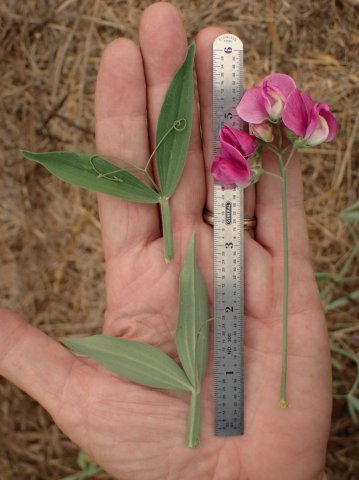Climate Matching Map
| Attachment | Size |
|---|---|
| climatematch-lathyrus_latifolius-california-20251029.pdf (1.17 MB) | 1.17 MB |
1. Question 1
2. Question 2
As well, the species is naturalized in Oregon and Washington, which have a similar climate.
3. Question 3
Considered to be invasive in some areas in the US (Missouri Botanical Garden)
The plant is an environmental weed in Victoria, Australia and on Lord Howe Island, it is listed as an invasive plant that is targeted for eradication. (Weeds of Australia)
This was noted as late-season monoculture in the San Francisco area. (R. Kesel, Pers. Comm.)
4. Question 4
Within a similar climate, the plant is listed as being invasive in Oregon, primarily referencing roadsides and rights-of-way (Oregon Dept of Ag).
Although it is noted that it is mainly a weed of disturbed sites and roadsides where it occurs in Australia, they do mention that it has invaded natural areas as well. The plant is listed as being invasive in Victoria, Australia, some of which matches the climate in California. (Weeds of Australia, Queensland)
5. Question 5
No other Lathyrus are on the noxious weed list in the region of interest.
6. Question 6
7. Question 7
8. Question 8
9. Question 9
USDA GRIN lists it as a vertebrate poison for mammals.
10. Question 10
11. Question 11
12. Question 12
13. Question 13
14. Question 14
The number of ramets in the field far exceeded the number of seedlings. (Hossaert-McKey and Jarry 1992)
A study of ovule position in natural populations in Europe showed some variation, but note an average of 10-12 flowers per inflorescence, maturing 0.5-1.5 pods each, and an average of 5-6 viable seeds per pod. This source did not mention the number of infl. per individual, but the numbers would likely be less than 1000 seeds per individual. (Hossaert & Valero 1988)
15. Question 15
16. Question 16
The plant is listed in garden blogs/web sales as flowering during the first year, and also unlikely to flower in the first year. None indicated that it would take longer than 3 years for the plant to flower.
17. Question 17
"The first flowers of both species appear in late June and early July, and the last pods mature in October. Each of the pink flowers ...stays open during about one week. Fertilized fruits require about one month for maturation." (Hossaert & Valero 1988)
18. Question 18
19. Question 19
20. Question 20
Evaluation Notes
Newer climate match link and map added 10/31/25 but associated answers to questions were not re-reviewed (J. Burger)




